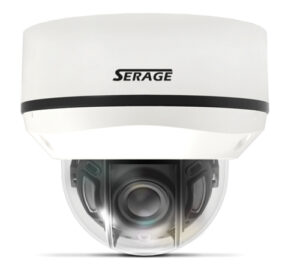 The camera provides a TVI compatible HD output along with an SD output and has motorised lens functions. Three high intensity infrared LEDs are mounted on each side of the lens to provide long range scene illumination. A stiff plastic strip is bonded to the inside of the clear bowl to prevent light from the LEDs leaking internally into the lens.
The camera provides a TVI compatible HD output along with an SD output and has motorised lens functions. Three high intensity infrared LEDs are mounted on each side of the lens to provide long range scene illumination. A stiff plastic strip is bonded to the inside of the clear bowl to prevent light from the LEDs leaking internally into the lens.
The camera has an ingress protection rating of IP68 and is stated as ‘Vandal proof’ but no IK impact code rating is given.
Getting started
The documentation is quite limited with the camera’s details provided on multiple sheets with the setup instructions in a small 18-page guide entitled EX-SDI (Extended Serial Digital Interface). This is quite misleading as the camera does not appear to support the SDI system, just the more common TVI (Transport Video Interface) for High Definition images. The Serage website did not at the time of testing provide any additional or updated details and also referred to SDI while promoting TVI standard cameras.
Connection is straightforward as the camera’s composite cable is provided with a Yellow BNC connector for the SD (Standard Definition) analogue output, a Black BNC for the HD analogue output and a 2-pole connector for the 12/24-volt supply input.
At power-up the camera displays its initial settings for approximately 8 seconds at the bottom of the screen on both the SD and HD outputs. The lens goes through a brief calibration routine and auto-focusses on the scene.
Operation
All camera functions are accessed by way of a miniature joystick switch mounted on the connection PCB in the dome’s chassis. Initially this joystick provides lens function control but if held down for a couple of seconds invokes the OSD menu structure. A two-pole connector next to the joystick can be used with the supplied phono connector lead to access the video feed from the camera for set-up purposes.
Installation is likely to be straightforward but care will need to be taken to ensure that the very small Allen screw in the side of the bayonet style mounting base is secured to lock the dome in place. The clear bowl must be carefully rotated to ensure the IR screening is correctly aligned with the lens.
The inclusion of the separate SD output lead means that for applications such as entrance monitoring, this feed can be used to drive a local monitor while the HD-TVI signal is fed back to the control room recorder.
Three axis sensor module adjustment means that it can be wall or ceiling mounted.
Menu Options
There are 11 menu options in total; the first two cover lens control features such as auto-focus configuration and exposure control. Six further options cover all image parameters including white balance, backlight compensation control, day / night switching with threshold levels and digital noise management. Two options cover operating modes for CCTV format setting and the final option is for serial control baud rate and camera address (0 to 255).
Read the full review in the May 2017 edition of PSI magazine


